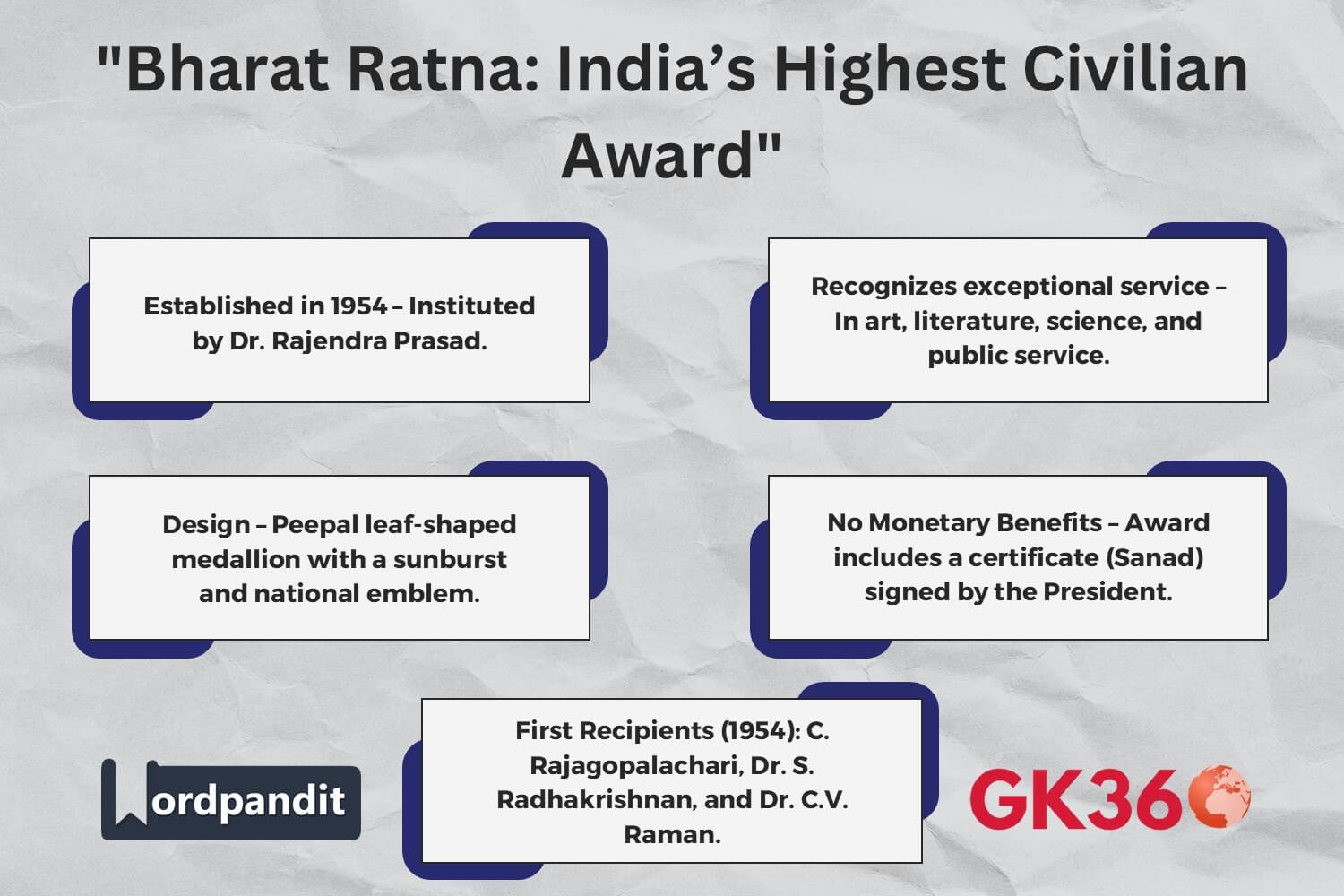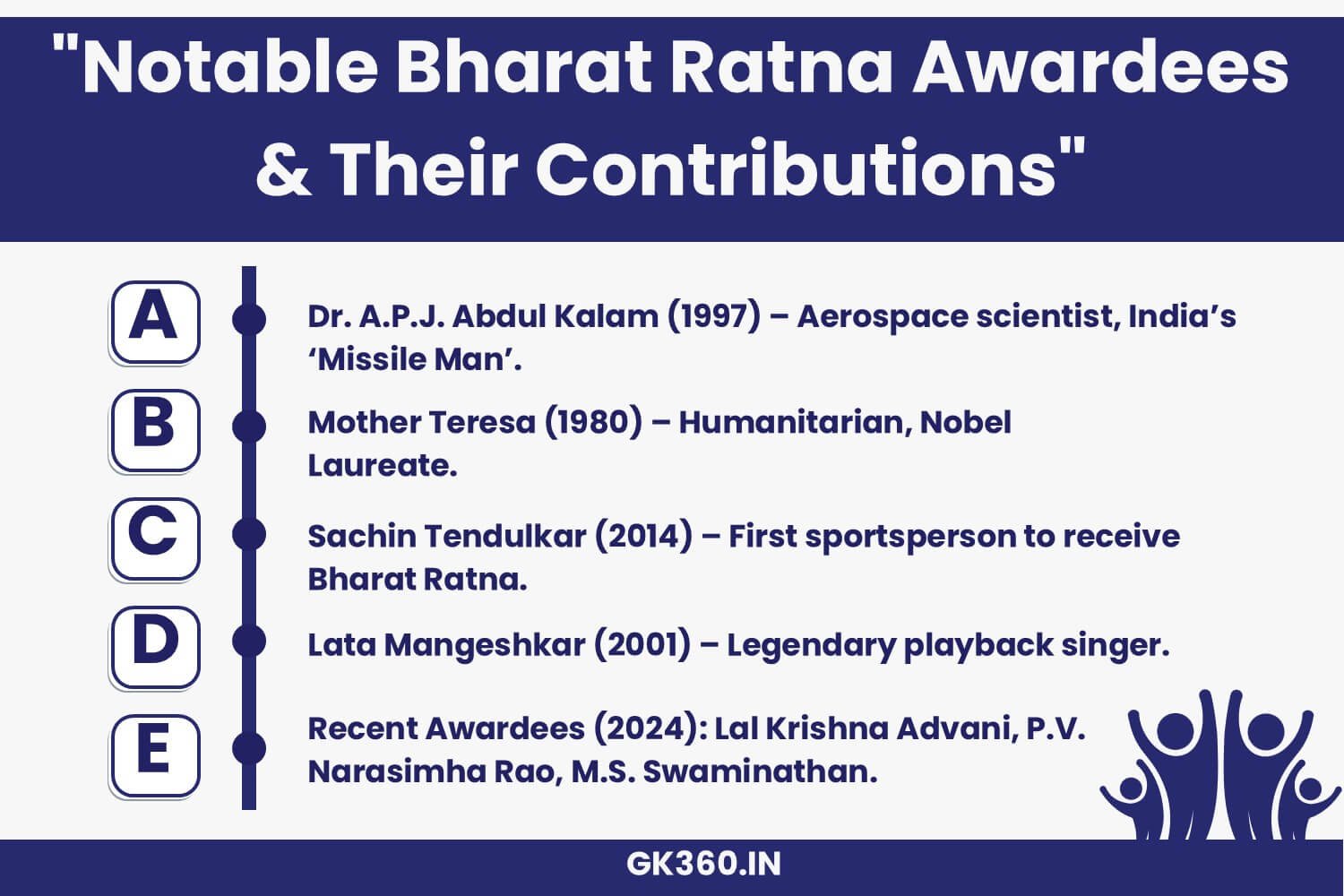Bharat Ratna: India’s Highest Civilian Award – History, Recipients, and Significance
Introduction
The Bharat Ratna is India’s highest civilian award, recognizing exceptional service in various fields, including art, literature, science, and public service. Established on January 2, 1954, this prestigious honor was initially limited to achievements in specific domains but later expanded to include all fields of human endeavor. It symbolizes India’s gratitude toward individuals who have made extraordinary contributions to society.

Table of Contents
- Introduction
- What is Bharat Ratna?
- History and Evolution
- Design and Symbolism
- Notable Recipients & Their Contributions
- Complete List of Bharat Ratna Awardees (1954-2024)
- Controversies & Criticisms
- Impact on Society & Nation-Building
- FAQs About Bharat Ratna
- Conclusion & Call to Action
What is Bharat Ratna?
The Bharat Ratna is India’s highest civilian honor, conferred by the President of India. It is awarded for distinguished service in various domains that contribute to national progress. Unlike many other awards, it carries no monetary benefit but includes a certificate (Sanad) signed by the President and a unique medallion.
History and Evolution
The award was instituted in 1954 by the first President of India, Dr. Rajendra Prasad. Initially, it was restricted to contributions in science, literature, and public service, but later, it was expanded to include all fields of human endeavor, making it more inclusive.
Design and Symbolism
The Bharat Ratna medallion originally had a circular shape but was redesigned in 1957 to resemble a peepal leaf. The obverse side features a sunburst design with “Bharat Ratna” inscribed in Devanagari script, while the reverse side bears the Indian state emblem and the national motto.
Notable Recipients & Their Contributions
Over the years, the Bharat Ratna has been awarded to numerous distinguished personalities, including:
- C. Rajagopalachari (1954) – Last Governor-General of India, freedom fighter.
- Dr. S. Radhakrishnan (1954) – Philosopher, former President of India.
- Dr. C.V. Raman (1954) – Nobel Laureate in Physics for the Raman Effect.
- Mother Teresa (1980) – Humanitarian, founder of Missionaries of Charity.
- Dr. A.P.J. Abdul Kalam (1997) – Aerospace scientist, former President of India.
- Sachin Tendulkar (2014) – First sportsperson to receive Bharat Ratna.
- Lata Mangeshkar (2001) – Legendary playback singer.
Complete List of Bharat Ratna Awardees (1954-2024)
Recent Awardees (2024)
- Karpoori Thakur (Public Affairs, Posthumous)
- Lal Krishna Advani (Public Affairs)
- P.V. Narasimha Rao (Public Affairs, Posthumous)
- Chaudhary Charan Singh (Public Affairs, Posthumous)
- M.S. Swaminathan (Science)
For the complete list of recipients from 1954 to 2024, refer to official government sources or visit GK360.in.
Controversies & Criticisms
While the Bharat Ratna is widely respected, its selection process has been debated. Some controversies include:
- Political Influence: Allegations of political favoritism in recipient selection.
- Exclusion of Deserving Candidates: Notable personalities from various fields have been overlooked.
- Delayed Recognition: Some awardees received the honor posthumously, raising concerns about delayed acknowledgment.
Impact on Society & Nation-Building
The Bharat Ratna serves as a symbol of excellence and inspires individuals to contribute to nation-building. It fosters a sense of national pride and encourages future generations to excel in their respective fields.

FAQs About Bharat Ratna
1. Who is eligible for the Bharat Ratna?
Any individual, regardless of nationality, can receive the award for exceptional contributions to society.
2. Can the Bharat Ratna be awarded posthumously?
Yes, posthumous awards are allowed. Several personalities, including Lal Bahadur Shastri and Dr. B.R. Ambedkar, have received the Bharat Ratna posthumously.
3. How is the recipient selected?
The Prime Minister recommends names to the President of India, who officially approves the award.
4. Who was the first recipient of Bharat Ratna?
The first recipients in 1954 were C. Rajagopalachari, Dr. S. Radhakrishnan, and Dr. C.V. Raman.
5. Has any foreigner received the Bharat Ratna?
Yes, Khan Abdul Ghaffar Khan (1987) and Nelson Mandela (1990) were awarded the Bharat Ratna for their contributions to peace and freedom.
Conclusion & Call to Action
The Bharat Ratna stands as the pinnacle of recognition in India, honoring those who have made significant contributions to the nation and beyond. Over the decades, it has celebrated excellence in public service, science, arts, literature, and sports, inspiring millions to strive for greatness.
Despite occasional controversies, the award continues to be a symbol of national pride and excellence. As India progresses, the Bharat Ratna serves as a testament to dedication, service, and the pursuit of knowledge, motivating future generations to contribute to the country’s development.
Key Takeaways Table
| Aspect | Details |
|---|---|
| Award Name | Bharat Ratna |
| Established | January 2, 1954 |
| First Recipients | C. Rajagopalachari, Dr. S. Radhakrishnan, Dr. C.V. Raman |
| Fields Recognized | Art, Literature, Science, Public Service, and Human Endeavor |
| Recent Recipients (2024) | Karpoori Thakur, Lal Krishna Advani, P.V. Narasimha Rao, Chaudhary Charan Singh, M.S. Swaminathan |
| Foreign Recipients | Khan Abdul Ghaffar Khan (1987), Nelson Mandela (1990) |
| Selection Process | Recommended by the Prime Minister, approved by the President |
Related terms
- Bharat Ratna Award Winners List
- Highest Civilian Award in India
- Bharat Ratna 2024 Recipients
- Bharat Ratna History & Significance
- Notable Bharat Ratna Winners
- Controversies in Bharat Ratna Selection
- Bharat Ratna Selection Process
- Foreigners Who Won Bharat Ratna
- Indian National Awards List
- Prestigious Awards in India





